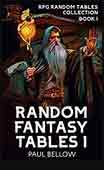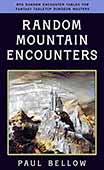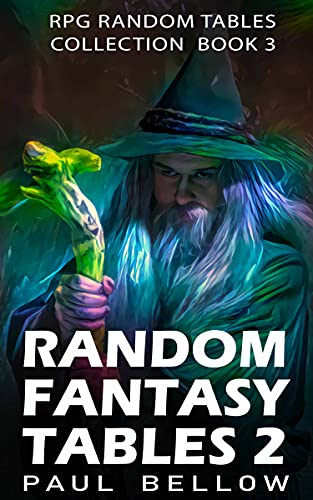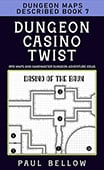Dragons. Their legends twine through the roots of fantasy itself, promising awe, terror, and the thrill of impossible treasure. But in too many tabletop RPGs, a dragon’s lair boils down to a dungeon-plus-fire-breath—little more than a brawny beast squatting atop a heap of gold. If you want your campaign to haunt your players’ dreams, that’s not enough. A truly memorable dragon lair is more than set decoration or a boss fight backdrop—it’s a living, breathing ecosystem, pulsing with history, logic, and personality.
This guide is your comprehensive resource for building dragon lairs that make sense, feel dynamic, and (above all) immersively support your D&D story. We’ll explore their role in narrative and tactical design: how a well-crafted lair shapes every moment, from creeping, torch-lit approach right down to the heart-pounding final confrontation. The right lair fuels tension, excites creative thinking, and cements your dragon as much more than a stat block—transforming it into a legend your players will never forget.
At the core of believability lies a paradox: dragons are supernatural, but they’re still animals with needs, rivalries, ambitions, and memories. Their homes must reflect both their magical nature and their place in the ecosystem—not just fantastical, but functional. Their lair isn’t mere habitat. It’s their fortress from enemies, their treasury of obsessions, the monument of their ego, and sometimes the prison of their regrets. The more logical and “lived-in” you make it, the more it pays off in both story and challenge.
Dragons influence every inch of their realm. When the lair’s features click together, when clues, hazards, and treasures echo the dragon’s personality, the encounter becomes more than another slugfest—it’s theatre, sport, and puzzle, all at once. The personalities of these ancient beasts should shape their homes as surely as their claws carve the walls. When that happens, every choice players make—whether it’s a stealthy infiltration or an all-out assault—gains resonance.
Our goal? Equip you with the tools to build dragon encounters that thrill, terrify, and stick with your players long after the dice stop rolling. We’ll help you go far beyond monster vs. adventurer. Let’s make your next dragon lair the stuff of legends.
What Makes a Dragon Lair “Believable”?
The spellbinding quality of a dragon’s lair isn’t just about spectacle—it’s about internal logic. To create a lair players can believe in, start by grounding everything in four core principles: ecology, personality alignment, environmental logic, and narrative weight.
Ecology means understanding the dragon as an apex predator with real needs—hunting grounds, water sources, escape routes, lair maintenance, and relationships with neighboring creatures. Even the magical should have roots in practical necessity: why this cave, this mountain, this ruined temple? What’s the dragon feeding on? How do smaller monsters—or humanoids—survive in its shadow?
Try my AI Tabletop RPG generators...and an extensive library of content!
Personality alignment is about tying every choice to the dragon’s mind and heart. The lair should reflect its owner’s vices, virtues, habits, and grudges. A gold-hoarding narcissist will build a lair meant to impress. A reclusive scholar will fill passageways with traps and libraries. Is your dragon proud and territorial, caring for trophies and the bodies of slain rivals? Or greedy and paranoid, layering obstacles between itself and inevitable thieves?
Environmental logic covers structure and geography. Entrances aren’t random—they fit the dragon’s movement and size. Lair defenses suit the dragon’s preferred fighting style and breathe with the same architecture as the world around them. If the lair wasn’t always a dragon’s den, how has it evolved? Has the dragon reshaped it, or adapted to its quirks?
Narrative weight comes from significance. A lair is more than an obstacle. It’s a monument to past victories, grudges, fears, and plans. Dragon lairs that feel meaningful help you tell better stories—with each chamber hinting at the dragon’s history and achievements.
⚔️ Fantasy RPG Random Tables Books
Make life as a Gamemaster easier…
If you play Dungeons & Dragons, Pathfinder, or other fantasy RPGs, this
RPG random tables series
is packed with encounters, NPCs, treasure, and more. Available in eBook or print—either way, you’ll have a wealth of adventure ideas at your fingertips.
Fifteen+ Traits of Believable Lairs
- Logical entrances and exits matching dragon size and movement
- Functional lair design (nest, vault, temple, or fortress)
- Physical evidence of previous victims (bones, weapons, stories)
- Terrain influenced by climate: frost, volcanic, temperate, jungle
- Scent, sound, and residue (acid burns, smoke stains, unnatural silence)
- Strategic placement: overlooks, defensible locations, hidden access
- Evidence of hunted prey and food storage
- Signs of humanoid or monster minion activity
- Layered passageways: tunnels, false trails, secret doors
- Environmental hazards (poison gas, lava flows, unstable stone)
- Personalized trophies and art
- Lair zones for different functions: sleeping, hoarding, guarding
- Traps and deterrents specialized against intelligent foes
- Remnants of long-ago battles (burned banners, collapsed walls)
- Adaptations for flight or breath weapon use
- Water features: pools, waterfalls, flooded tunnels
- Magical influences: lingering spells, enchantments, strange flora
- Scarred geography: melted stone, frozen plants, fey-warped mushrooms
Consistency is the anchor for even the grandest ideas. If you want awe-inspiring, go strange—but always ask “why?” Dragons don’t just occupy a space. They twist it to their nature over centuries, stamping it with their legend.
Never forget: even a lair on the edge of reality is improved by internal logic. When everything fits, your players can lose themselves in the world—and then, when awe turns to fear, they’ll know that legend is about to become a fight for their lives.

Environmental Design: Terrain and Layout
Every hero remembers the place where they almost died—a bridge of ice over a bottomless pit, a magma-lit cavern filled with boiling vents, a rotten stairway by a cliff’s edge. The terrain of a dragon’s lair is more than flavor; it’s the crucible through which stories are forged and battles won or lost. Whenever you design a lair, envision more than lines on a graph—think in three dimensions, from soaring chambers to claustrophobic burrows.
Geography twists exploration and fighting into something uniquely pulse-pounding. A lair with sharp elevation changes lets dragons swoop, dive, and rain terror from above while forcing ground-bound PCs to clamber across risky ledges. Choke points grant defenders impenetrable positions but can also become kill zones for daring attackers. Meanwhile, multiple lair “zones” (entrances, hoard chamber, escape vents, minion den, hidden reliquary) shape both the narrative arc and the tactical flow of encounters.
Natural hazards also inject narrative flavor and mechanical teeth. A lair at the edge of a volcano isn’t just hot—it’s dangerous, filled with labyrinthine tunnels cut by lava flows and collapses, possibly even shifting over time. Submerged caves might conceal silent, deadly guardians or force underwater navigation. Overgrown root-warrens can block vision, stifle sound, and serve as the dragon’s secret passages. Each environment confers unique advantages, pushing the party to adapt their approach.
Most important of all: tone. A lair’s layout can communicate dread, grandeur, madness, or melancholy without a single word spoken. Spiraling descent brings mounting tension. High, airy vaults evoke majesty and risk. Twisting tunnels induce claustrophobia and paranoia. How the rooms link, how light and sound flow, and how the ground itself might shift or betray—these all set the mood for your coming showdown.
Twenty+ Terrain Features & Layouts for Lairs
- Volcanic caldera chambers
- Flooded tunnels and sunken sanctums
- Cliffside or mountain-ledge caves
- Inverted spire (narrow at base, opens above)
- Network of burrowed tunnels (earth dragon)
- Forest glade “fortress” (ancient roots, hidden among trees)
- Hanging caves with drop-offs
- Fields of petrified statues/victims
- Ancient, ruined fortress taken over
- Glacial caverns with shifting ice bridges
- Hollowed-out giant trees (green or forest dragons)
- Caves festooned with hanging chains, webs, or vines
- Magically floating platforms and bridges
- Subterranean labyrinth tied to the Underdark
- Lake island lairs (accessible only by water or flight)
- Mine complexes reworked by dragon
- Smoky, fog-filled hollows for hiding
- Fumarole vents or boiling mud pits
- Disorienting mirrored corridors or illusory rooms
- Spiral staircases wound around pit or shaft
- Rooftop nests above city ruins
Environments work best in layers. Multi-tiered chambers, tunnels snaking off in different directions, and interconnected ecosystem “zones” turn a single-note lair into a living setting. Let the party fight for control of the heights, wonder what lurks beneath the surface, and try to predict where the dragon will strike next.
A dragon’s lair should always be deeper than it seems—literally and figuratively. Each new passage, level, or hazard adds possibilities and peril, ensuring battles are dynamic and stories come alive with every risky stride.
Integrating the Dragon’s Personality
A dragon’s lair is never just walls and treasure—it’s a cathedral to its own ego, neuroses, and ancient grudges. If you want your lair to haunt players after the final battle, let it speak with the dragon’s own invisible voice.
Start with alignment and motivation. Lawful dragons, obsessed with order, may construct scrupulously organized chambers and vaults—security systems precise as clockwork, trophies arranged by century, and magical defenses reset religiously every morning. Chaotic dragons delight in unpredictability: warped passageways, erratic traps, and unexpected dead ends. Is this the lair of a tyrant, a scholar, or a monster haunted by its memories? Each will stamp their home with matching fervor.
Motivation deepens detail. Greedy dragons surround themselves with hoards—and maybe plunder their enemies’ shrines to display as “war trophies.” Vain dragons create galleries accenting their beauty with polished golden mirrors, stylized mosaics, or magical illusions. Paranoid reptiles carve escape tunnels and fill dead spaces with traps, acidic slimes, or illusory duplicates. Dragons who desire worship might even shape their lair as a mock temple or hallowed tomb, replete with sacrificial altars.
⚔️ Fantasy RPG Random Tables Books
Make life as a Gamemaster easier…
If you play Dungeons & Dragons, Pathfinder, or other fantasy RPGs, this
RPG random tables series
is packed with encounters, NPCs, treasure, and more. Available in eBook or print—either way, you’ll have a wealth of adventure ideas at your fingertips.
Age is a force of transformation. Young dragons hide, carving simple dens that maximize concealment and rapid flight. Adults expand—glaring over their domains, adding outer defenses, recruiting minions, and stockpiling stolen wonders. The lairs of ancients are the stuff of legend: immense, labyrinthine, washed with the scars of centuries, and haunted by memories of both failed heroes and loyal minions whose bones line the walls. Every inch reflects a life of triumph—and paranoia.
Eighteen+ Ways to Reflect Dragon Personality in Lair Design
- Artistic or grisly trophy galleries
- Collections of magical or unique items (obsessions)
- Arcane sigils, runes, or wards tailored to dragon’s magic
- Minion barracks (goblins, kobolds, cultists)
- Trapped or illusion-enshrouded doors—paranoia
- Altars or shrines built by enslaved worshipers
- Mosaics, murals, or etched histories “written” by the dragon
- Hoard organization reflecting greed or orderliness
- Living gardens or magical constructs (if druidic or fey-related)
- Ritual chambers for magical research or sacrifices
- Themed architecture—serpentine, crystalline, fungus-grown
- Prison cells or petrified “guests”
- Paranoid overuse of traps and dead ends
- Statuary, mirrors, or windows to enhance vanity
- Sound design (or magical silence) matching temperament
- Dedicated “memory chambers” of fallen enemies
- Secret passages for eavesdropping or flight
- Lighting choices: darkness, glowing gems, hellfire braziers
Never underestimate the value of letting your lair function as a character. The most memorable dungeons feel as though they’re alive, pulsing with intent. When your players walk through a dragon’s home, they’re wandering its psyche—not just a monster’s den, but a legend’s lair.
Keep asking: “What would my dragon cherish? Fear? Want to display, or hide?” Let the answers shape not just the décor, but the entire adventure.
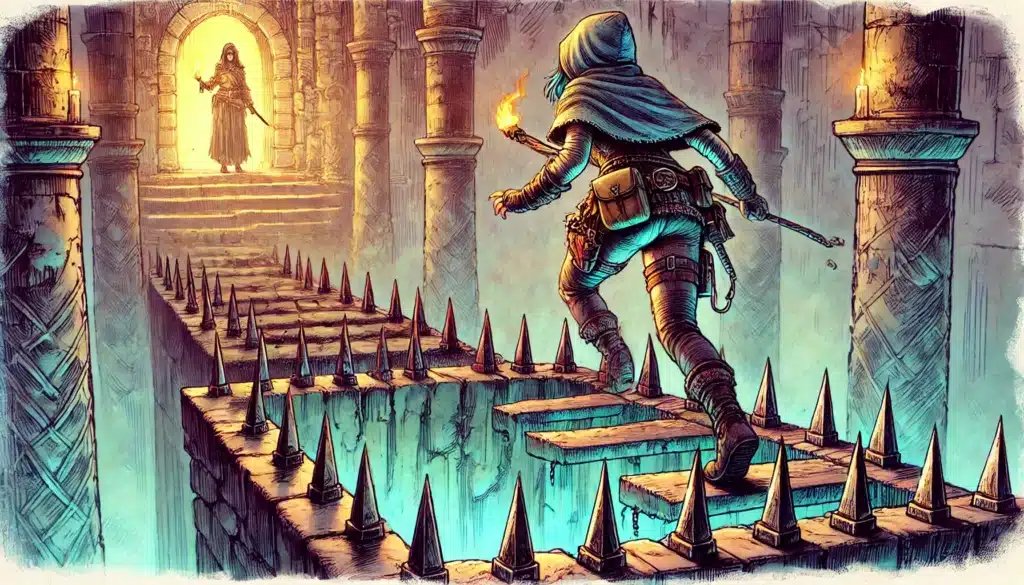
Lair Defenses and Inhabitants
Dragons rarely trust their lives to stone and spell alone. Their lairs teem with cunning defenses—some mechanical, some magical, some living. These aren’t just obstacles; they’re evidence of an ancient, paranoid mind intent on surviving every would-be hero foolish enough to cross its threshold.
Traps aren’t mere damage-dealers—they’re statements. Each tripwire, pitfall, or magical glyph tells adventurers: this place is dangerous, and its owner is clever. Some lairs bristle with low-tech deterrents—deadfalls, spiked pits, collapsing bridges. Others shimmer with arcane wards: runes that sap strength, alarms that alert the dragon to intruders far before the hoard is threatened.
But even the best trap is useless without eyes and ears. Dragons maintain networks of minions: kobold engineers, cultist fanatics, enslaved monsters, or even charmed elementals. These aren’t just cannon fodder—they’re a living layer of surveillance, offering warnings, buying time, and shaping the lair’s day-to-day operations. A lair’s food chain might contain everything from sapient lizardfolk to fungus-crawling scavengers, all with their own stories and fears.
Environmental hazards turn home advantage into a weapon. Vents spew scalding steam. Pools hide toxic algae or magical parasites. Cliffs and crevasses beg for falls. Even the walls might shift, closing off escape—or herding intruders toward the dragon’s chosen killing ground. And always, the lair remembers old battles: bones of past victims, spent traps, even the shattered relics of previous adventurers are incorporated into its design.
Twenty+ Defensive Mechanisms for Dragon Lairs
- Timed fire or acid vents
- Sleep-inducing spore clouds
- Scrying circles monitoring entryways
- Collapsing bridges or tunnels
- Pressure plates with falling rock traps
- Wards that dispel magic or reveal invisible foes
- Magically bound elemental guardians
- Alarm bells or enchanted horns
- Sentient minion lookout posts
- Sticky slime or webbed corridors
- Poison dart or acid spray mechanisms
- False doors or mimic impersonators
- Teleportation traps (random or targeted)
- Sacrificial ward stones sapping intruder strength
- One-way doors or escape chutes for the dragon
- Magically-locked gates requiring passwords or rituals
- Enchanted armor or weapons that attack trespassers
- Cursed objects among the treasure
- Environmental disasters: rockfalls, flash floods, ice storms
- Dream-invading spirits sowing confusion
The key to great defense is escalation. Let outer chambers deter the bold but unworthy: traps that cause alarm or send intruders fleeing. Only the truly dangerous should make it to the inner sanctum—where every hazard, minion, and magical defense ramps up the desperation.
A dragon’s lair should never simply “lie down.” Each layer should whisper that behind every trap or minion, a mind is watching—waiting for the final challenge.
Designing for Lair Actions
At higher tiers of play, lair actions are a dragon’s ace-in-the-hole: environment-shaped powers that twist the odds, set tone, and make the villain feel truly home-field. But lair actions work best when tailored to both the dragon and its setting. They shouldn’t be “random” magic tricks—they should feel like the working of an ancient will, embedded in rock, fire, or air.
Lair actions express dominance. A dragon with mastery over stone might collapse ledges or raise barricades. One bound to frost might freeze passageways, force PCs to scramble for footing, or summon bursts of howling wind. The best actions interact with existing hazards—triggering volcanic eruptions, summoning fog for ambush, or rotating the very chambers themselves below the unwitting party’s boots.
Pacing is everything. Telegraph danger with subtle environmental clues—a crackle of arcane energy, a gout of smoke, a sudden silence before a metaphysical storm. Don’t spam lair actions every round; use them to signal shifts in the battle, force tactical adaptation, and reinforce the idea that the lair itself resists intruders.
Try my AI Tabletop RPG generators...and an extensive library of content!
Most importantly, lair actions should shape the story of a fight, not just its math. They’re moments of escalation, surprise, or horror—proof that inside the dragon’s domain, even the ground is your enemy.
Fifteen+ Homebrew Lair Actions by Environment and Theme
- Gravity reversal for one round on a sky-bound platform
- Magma geysers erupting, flooding part of the lair
- Sudden ice storms or freezing mists (frost dragon)
- Darkness or magical fog blanketing a chamber
- Poisonous spores release in a fungal lair
- Telekinetic winds slamming or shoving PCs
- Stone jaw pits snapping shut under trespassers
- Spiraling confusion mazes (magical illusions)
- Summoning spectral echoes of former victims
- Animate treasure: coins become biting constructs
- Spontaneous chasms open or close
- Oozes/acid pools surge to block escape routes
- Frightening roars—sonic assaults cave in fragile ceiling
- Living roots entangle or separate PCs
- Magnetic pulses disarm or pin armor-wearing foes
Always remember: lair actions should elevate the dragon, not steal the spotlight. Use them to support your villain’s strengths, forcing the party to react and improvise without overwhelming them with despair.
When done right, the line between monster and lair vanishes—every tremor, every shadow, every gust of scorching or freezing wind is the dragon’s will made manifest.

Regional Effects That Tell a Story
The true power of a dragon echoes far beyond its walls. The earth sickens, animals flee, and even the weather seems to conspire. These regional effects aren’t just mechanical flavor—they’re the slow heartbeat of myth, warning all who draw near that this is no ordinary wilderness. They prepare players for what’s coming and let the world feel alive with danger, dread, and restless memory.
Well-designed regional effects create atmosphere from the moment the party approaches. Ashfall or toxic fog can signal chromatic dragons in residence; weird auroras or lightless nights whisper of more arcane breeds. These phenomena—subtle or overt—warn that nothing is natural here anymore, and sometimes serve as clues to a dragon’s type, powers, or personality.
Such effects can alter encounters even miles from the lair. Starving predators driven mad by unnatural hunger, missing townsfolk, rumors of ghostly voices in dreams—these all foreshadow the dragon’s reach and set the rhythm of the campaign. Smart players may exploit or try to mitigate these hazards before even facing the beast.
A dragon’s “shadow” tells a story of its own. The farther-reaching, the older and more powerful the beast. Use these influences to reinforce not only your monster’s might, but its unique stamp on the landscape’s myth.
Sixteen+ Regional Effects by Dragon Type and Terrain
- Animals acting with unnatural aggression or fear
- Weather distortions: constant rain, drought, supernatural storms
- Sickly, mutated or blighted plants (green, black, or necrotic dragons)
- Pools or streams become toxic or acidic
- Nightmares and invasive dreams for nearby sleepers
- Shadows lengthen or sounds dull within a set radius
- Wild magic zones/surges (fae-influenced lairs)
- Unexplained disappearances or ghostly voices on the wind
- Swarms of insects/rodents drawn to or from the lair
- Time of day subtly twisted (longer nights, shorter days)
- Unceasing auroras or creeping darkness
- Gravity acts unpredictably (sky or cosmic dragon)
- Structures rot or stonework crumbles without reason
- Sudden overgrowth or strangling vines
- Flocks of predatory birds circling ceaselessly overhead
- Water freezing or boiling out of season
- Locals speaking in tongues or under mild mind control
These effects are more than set dressing. They’re passive adventures—environmental storytelling with consequences. Any detail that hints at the dragon’s power, without revealing everything at once, will deepen immersion and tension.
Great regional effects remind your players: even the ground beneath your feet is the dragon’s to command. Soaked in myth, hostile to mortals, these are lands where legends stalk the land—and danger is never more than a misstep away.
The Role of Treasure in Dragon Lairs
No one survives a dragon’s lair and forgets what they saw. The hoard isn’t just loot—it’s living history, the memories of kingdoms, the bloody tally of broken adventurers and failed empires. In your hands, treasure becomes both temptation and storytelling tool, dazzling with promise and lurking with danger.
The most engaging hoards belong to the dragon as much as the players. Every coin, cursed relic, and forgotten statue should speak of conquests past: honored enemies, favorite victims, half-finished schemes. Sometimes, the very treasure is the trap—glamoured gold, polymorphed prisoners, or lures that summon the dragon’s return. Don’t settle for random tables: aim for thematic resonance.
⚔️ Fantasy RPG Random Tables Books
Make life as a Gamemaster easier…
If you play Dungeons & Dragons, Pathfinder, or other fantasy RPGs, this
RPG random tables series
is packed with encounters, NPCs, treasure, and more. Available in eBook or print—either way, you’ll have a wealth of adventure ideas at your fingertips.
Treasure is layered in mystery. A magical sword once wielded against the dragon—broken, its magic half-drained, its inscription a clue to past battles—will mean more than ten thousand coins. Symbolic trophies, documents, and art can reveal a timeline of regional wars, shifting alliances, and rival villains. Let players fill in stories from their discoveries, piecing together a saga that’s as much reward as any magic item.
Cursed relics, unfinished wonders, or hoard guardians (trapped spirits, animated statues) remind players that riches rarely come without risk. Treasure, too, should be defended, forgotten, or wounded by the ravages of dragon pride and time.
Twenty+ Hoard Concepts to Deepen Your Dragon’s Story
- Cursed relics of ancient, fallen empires
- Magical items left unfinished or sabotaged
- Symbolic trophies (crowns, banners, sacred relics)
- Traps disguised as golden coins, goblets, or gems
- Polymorphed prisoners frozen as statues or animals
- Scrolls or tomes, charred but partly legible
- Living magical pets (miniature dragons, fae, elementals)
- Shattered statuary, some mended with gold
- Ornate chests bound by arcane puzzles
- Blood-stained armor of long-dead champions
- Gems with animated scenes inside
- Ghosts or echoes of former thieves
- Jewelry infused with the dragon’s own magic
- Mirrors showing alternate timelines or past glories
- Preserved eggs (own or stolen rivals)
- Enchanted musical instruments
- Vials of tears, venom, or breath
- Broken siege weapons
- Books of prophecy or forbidden lore
- Ancient contracts or pacts, partly devoured
- Dragon-sized personal items: goblets, jewelry, or writing implements
Treasure isn’t a footnote. Treat every element as a possible hook—a mystery, an omen, a legacy. Let it fuel new quests, rivalries, and dilemmas.
A good hoard is worth more than its weight in gold. Link treasure to the region’s plot and lore, and it will shape the campaign for sessions to come—proof that victory always comes at a price.

Building Encounter Flow Within the Lair
Great dragon lairs unfold like a symphony. Too many GMs jam every monster into the front door or drag out a single, bruising slog. Instead, create a rhythm of tension and challenge—spending peaks and lulls carefully, pushing the party toward their final confrontation both battered and breathless, but not broken.
Start with outer defenses: minions, sentries, hazards that cost time or resources while foreshadowing the dragon’s presence. Inside, shift the focus to puzzles, traps, and dangerous terrain—obstacles that test more than just hit points. As PCs close in, present major minions or environmental hazards at a crucial crossroads, forcing strategic decisions about when to conserve spells and when to gamble. Finally, culminate with a throne room, hoard chamber, or open vault—often the perfect stage for a dragon’s lair actions and its most dramatic tactics.
Pacing is your best weapon. Drive the tension with waves of pressure, but don’t let the party burn out prematurely. Give them moments to recover—brief lulls, clues, or even captured informants—before hammering them with the next challenge.
The best dragon lairs keep players guessing, adapting, and second-guessing every step into the unknown. From the faintest rustle outside the entrance to the titanic roar in the hoard room, every beat should feel earned.
| Encounter Stage | Enemies or Hazards | Player Goals | Environmental Challenges |
|---|---|---|---|
| Outer Approach | Scouting minions, traps | Gain entry unseen | Concealed alarms, unstable paths |
| Entry Guardians | Kobold sentries, enchanted statues | Breach first defenses | Narrow tunnels, collapse risks |
| Warning Chambers | Illusory warnings, minor monsters | Gather intel, avoid alert | False doors, magical illusions |
| Patrol Corridors | Roaming drakes or humanoids | Advance while hidden | Shifting floors, choke points |
| Trap Gauntlet | Mechanical/magical traps | Survive/disable dangers | Timed doors, acid pits |
| Minion Barracks | Leader minions, spellcasters | Defeat/avoid reinforcements | Cover, sound-dampening spells |
| Environmental Zone | Lava pools, freezing mists | Traverse/test endurance | Hazardous terrain, low visibility |
| Sanctuary | Injured minion, possible clue | Gather info/heal | Trapped furnishings, curses |
| Antechamber | Elite guardians, lair actions | Final prep, weaken foes | Unstable ground, lair effects |
| Dragon’s Throne | The dragon itself | Confront and defeat villain | Multi-level battle, lair actions |
The right cadence makes every room feel distinct—forged by the dragon’s will, haunted by danger, and poised for story. Don’t be afraid to let the party breathe, question, or panic; then, drive them onward with the promise of ultimate glory or annihilation.
A great dragon lair is a journey—each chamber a step closer to the monster’s heart.
How Dragons Use Their Homes in Combat
Dragons are apex predators for a reason. When the fight turns desperate, they use every inch of their lair: darting through tunnels, vanishing behind curtains of smoke, and unleashing their deadliest attacks from ambush. If you want your final battle to feel legendary—not just brutal—run the dragon like the mastermind it is.
Dragons know their homes better than any intruder. They hit and run, forcing parties into kill zones and splitting up groups with collapsed bridges or triggered floods. High ceilings and deep pits turn vertical space into a weapon—dragons dive, strafe, and snipe from above, rarely staying still long enough to get cornered.
Psychological warfare is their true breath weapon. Dragons bait overconfident heroes with exposed treasure, feign weakness, and taunt with half-remembered tales of failed challengers. Some will channel spells through their lair; others will manipulate light, sound, and terrain to sow confusion and terror.
A dragon in its element is more than a beast: it’s a force of nature. Every round should feel like a desperate contest for survival—an encounter where the world itself turns against invaders.
Eighteen+ Tactical Lair Uses for Dragons
- Luring PCs onto fragile bridges, then collapsing them
- Using fog, smoke, or darkness to obscure line of sight
- Shoving or dragging PCs into water, acid, or lava hazards
- Triggering environmental hazards (floods, gas vents) mid-combat
- Flying out of reach and striking with breath from above
- Baiting PCs with glimpses of treasure, then ambushing
- Forcing parties into choke points for breath weapon attacks
- Retreating to heal or create distance
- Harassing casters or ranged attackers from cover
- Smashing support columns to alter terrain
- Using pre-placed traps defensively
- Blocking exits to prevent escape or reinforcements
- Teleporting or vanishing (if magical) to reset engagements
- Utilizing minions as living shields or distractions
- Dropping heavy objects (statues, stalactites) on intruders
- Forcing combat underwater or in zero-gravity
- Feigning retreat or surrender to split enemies
- Disorienting with deafening roars or illusions
Remember: the dragon is the lair. Let it use its home as both shield and sword—it should never feel static or outwitted by mere invaders.
When your party faces a dragon and comes away stunned by its cunning, you’ve succeeded. These monsters should shape every room, every tactic, every nightmare to come.
Designing Lairs That Fit in the World
A lair isn’t just an isolated bolt hole—it’s a living piece of your campaign tapestry. The best dragon homes are woven into myth, legend, history, and rumor. Choosing the right location and tying it to the world’s lore gives weight to every approach and pause, letting players sense the dragon’s influence even before they cross its threshold.
Think like a storyteller: why is the lair here? Did the dragon defeat another, ancient entity to claim it? Do local folk whisper of vanished heroes or forbidden places on their maps? Use festival tales, ruined monuments, and hints in old books to build anticipation before the lair is ever in sight.
Lairs make excellent plot drivers. A sunken temple is both a logistical nightmare and a legendary prize; a fortress atop a cliff signals both military power and untold dangers below; a floating lair is a challenge in itself, perhaps defended by magical storms or unsolvable riddles. Each distinct location shapes not just encounters, but the story of the dragon—the burdens it bears, the wars it’s survived, and what it means to the world around it.
Ask how locals perceive the lair. Is it infamous, driving migration and curses for miles? Or is it a secret, masked by glamour, defended by unwitting pawns who don’t even know their master’s true form? Use NPCs, old maps, or even rival enemies to enhance the mystery or menace.
Fifteen+ Example Lair Locations with Worldbuilding Hook
- Sunken temple in a drowned jungle, guarded by sea elves
- Cliff-face fortress overlooking a war-torn valley
- Floating island above a ruined city, shrouded in storms
- Within the bones of a slain titan or primordial behemoth
- Ancient dwarven mine, now twisted and poisoned
- Colossal petrified tree at the heart of an enchanted forest
- Fumarole riddled badlands, marked with scorched runes
- Subterranean labyrinth beneath a sacred burial ground
- Long-abandoned wizard’s tower, warped by arcane fallout
- Glacier heart chamber, reachable only by crevasse descent
- Dead volcano summit, home to both dragon and rival cult
- Hidden oasis lashed by monsoons, haunted by illusions
- Forested canyon, disguised by perpetual mists
- Ruined coliseum, its ancient magic now dragon-bound
- Desolate desert cave shielded by mirage and shifting sand
- Fae-crossed crossing—appears only under the full moon
Lairs can cast a long shadow—feared, shunned, or mythologized by those who live nearby. Or, their secrecy can drive rumors, sabotage, and quests to uncover their secrets.
The location itself should offer adventure hooks beyond the dragon—mysteries to solve, alliances to forge, enemies to outwit. The best lairs aren’t just a final battle—they’re enduring scars or wonders on the map, changing the world forever.

Final Thoughts on Legendary Lair Design
The dragon’s lair is the crucible where campaign legends are born. To make it sing, keep the essentials in mind: ecological realism grounds the magic, narrative symbolism makes every detail matter. Tactical integration turns every chamber into a puzzle and every hazard into part of the dance. Personality-driven details elevate the lair from simple battleground to living story.
⚔️ Fantasy RPG Random Tables Books
Make life as a Gamemaster easier…
If you play Dungeons & Dragons, Pathfinder, or other fantasy RPGs, this
RPG random tables series
is packed with encounters, NPCs, treasure, and more. Available in eBook or print—either way, you’ll have a wealth of adventure ideas at your fingertips.
Don’t be afraid to experiment—mash genres, twist expectations, or riff off your players’ anxieties. Pay attention to their reactions, gather feedback, and revise the lair where necessary. The best lairs are never static; they evolve with both world events and player agency.
Remember, your work isn’t done at the stat block. Every lair you create is another piece of the world—living testament to fallen heroes, ancient grudges, and the inscrutable glory of the dragon within. Take notes! The most immersive lairs are built from a thousand little decisions, all rooted in logic and lore.
Great lairs do more than host battles; they shape campaigns. They become touchstones in your players’ stories—landmarks that future heroes reference in awe or dread. If you build well, your dragon’s lair becomes the kind of place your players never forget, whispering their story in every corridor and treasure trove.
Above all, let every room, every bone, every echo within the stone serve a purpose. It should whisper, thunder, and finally roar the story of the dragon that built it. That’s the secret that turns a lair into a legend.


